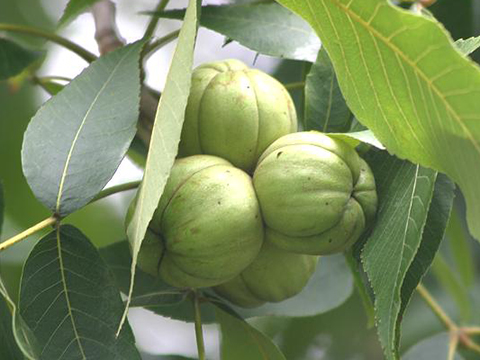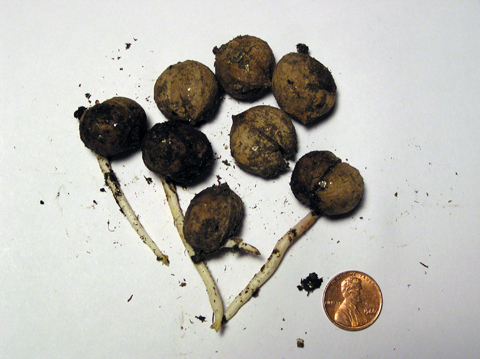 |
| Home | Ordering By Mail | Purchase Manual: Using Native Plants in Urban Landscapes |
|
|||||
Species Name: Carya ovata
Common Name: Shagbark Hickory
Zone: 4 to 9
Distribution: southern Maine to Michigan in the north, south to Florida and Texas
Seed collection: Collect nuts of Shagbark hickory in September through October in New York.
Nuts can be collected directly from the tree beginning in early September or later from the ground as the nuts naturally fall.
Nuts are enclosed in a thick woody 4 part husk that splits and readily falls away from the nut at maturity.
Husks are more difficult to remove from the nuts if collected early while still on the tree.
The nuts are 2 to 3 inches in diameter and very sweet and nutritious. But the nuts are small and for this reason are seldom eaten by people.
Large trees may produce 2 to 3 bushels of nuts. Trees produce large nut crops at one to three year intervals.
Open grown trees often reliably produce nuts every year.
Seed handling: Seed can be collected from the ground after falling or directly from low hanging branches.
Separate nuts from the husk if husks are still attached. Plant nuts immediately in prepared seedbeds,
in deep containers or in natural soils. Protect from rodents if possible and keep moist to maintain viability.
Nuts may also be stratified and stored for planting in the spring or as they begin to germinate.
Nuts can withstand freezing winter conditions but ideally in storage hold nuts at temperatures just above freezing .
Germination requirements: Nuts germinate at fairly high percentages. According to tests conducted 60 to 75% of the nuts
are viable and produce seedlings. Nuts germinate over a long period of time from spring throughout the summer months
if sufficient moisture is present in the soil. Germinating nuts initiate a long taproot, reaching nearly a foot in length before the shoot emerges.
The taproot functions to reach moisture and nutrients deep in the soil below the roots of other plants and aids the seedling
in competing with other plants in drought prone soils. The taproot may also offer the seedling survival advantages in fire prone habitats.
Breaking the taproot or root pruning the seedling will stimulate lateral roots to grow.
This practice is beneficial under nursery production in developing a better root system that can withstand the shock of transplanting.
Ecology: Shagbark hickory is a medium to large tree that on good soils can reach over 80 ft tall and 24” in diameter.
Shagbark wood is hard and dense, it is a valuable timber species and it makes a superb firewood fuel.
Shagbark is adaptable to a wide range of soils and moisture levels. It occurs in mixed stands with numerous other hardwood species
or occasionally in pure stands. It is one of the few trees that can thrive in heavy clay soils. It reaches a large size on fertile deep bottomland soils.
It prefers calcium rich soils, neutral to slightly acidic. It is a common associate with several oaks species in oak/hickory forests types
where it shares the same affinity for dry well drained upland soils.
Hickory nuts are sweet and highly nutritious. They are a primary mast tree along with the oaks in supporting a host of wildlife species.
They are readily eaten by a range of animals ranging from mice, squirrels and chipmunks to turkey, deer and black bear.
Grey squirrels are the primary dispersal mechanism for hickory as the nuts seldom are able to survive under the parent tree.
Squirrels cache large quantities of nuts in the soil away from the parent tree for retrieval during the long winter months
but many of the nuts remain unclaimed allowing them to germinate.
Hickory seedlings are moderately shade tolerant to shade intolerant and do poorly in a closed canopy with too much shade.
The seedlings develop a strong deep root system the first few years of growth, which can then support strong vigorous shoot growth.

Shagbark nuts on the tree

Shagbark hickory nuts beginning to germinate.
A tap root extends deep into the soil before the shoot emerges.
this page posted February 25, 2015